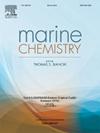In situ measurement of trace sulfide concentrations in marine coastal waters using diffusive gradient in thin film passive samplers
IF 2.5
3区 地球科学
Q2 CHEMISTRY, MULTIDISCIPLINARY
引用次数: 0
Abstract
The diffusive gradient in thin film technique (DGT) represents an in situ passive sampling method designed to preconcentrate various compounds, including sulfides, for detection at low concentrations. While DGT applications for sulfides have been studied in freshwater, this research extends its use to marine environments. A detailed methodology is presented for synthesizing, assembling, calibrating, and field-deploying DGT samplers to measure sulfides in the low micromolar range in marine waters. The in-house DGT samplers developed in this study demonstrated improved performance, with more homogeneous binding gels and smaller silver iodide particles (0.51 ± 0.34 μm) compared to commercial alternatives. Grayscale imaging enabled accurate quantification of sulfide accumulation in the gels, confirming the method's reliability for detecting trace-level sulfides in marine environments. Comparative analysis showed in-house and commercial samplers performed similarly in estimating sulfide concentrations. Field deployments along the Peruvian coast revealed significant vertical and spatial sulfide gradients. In the Callao coastal area (12°S) (July–August 2022), concentrations ranged from 0.03 to 0.45 μM across a 35 m depth profile. In Paracas bay (13.8°S) (March–April 2023), a shallower coastal station, concentrations ranged from 1.17 to 6.46 μM, reflecting increased benthic production. These results highlight the utility of DGT samplers as cost-effective tools for biogeochemical monitoring, enabling studies of the ocean sulfur cycle. The findings emphasize the growing application of DGTs in marine and coastal water column research.
用薄膜被动采样器扩散梯度原位测量海洋近岸水域中痕量硫化物浓度
薄膜技术中的扩散梯度(DGT)代表了一种原位被动采样方法,旨在预先浓缩各种化合物,包括硫化物,以便在低浓度下进行检测。虽然已经在淡水中研究了硫化物的DGT应用,但本研究将其应用扩展到海洋环境。详细的方法提出了合成,组装,校准,并现场部署DGT样品测量硫化物在低微摩尔范围内的海水。与商业替代品相比,本研究开发的内部DGT样品具有更均匀的结合凝胶和更小的碘化银颗粒(0.51±0.34 μm),性能得到了改善。灰度成像能够精确量化凝胶中的硫化物积累,证实了该方法在检测海洋环境中痕量硫化物方面的可靠性。对比分析表明,内部取样器和商业取样器在估算硫化物浓度方面表现相似。沿着秘鲁海岸的现场部署显示了显著的垂直和空间硫化物梯度。在卡亚俄沿海地区(12°S)(2022年7月至8月),35 m深度剖面的浓度范围为0.03至0.45 μM。在Paracas湾(13.8°S)(2023年3月至4月),一个较浅的海岸站,浓度范围在1.17至6.46 μM之间,反映了底栖生物产量的增加。这些结果突出了DGT采样器作为生物地球化学监测的经济有效工具的效用,使海洋硫循环的研究成为可能。研究结果强调了DGTs在海洋和沿海水柱研究中的应用日益广泛。
本文章由计算机程序翻译,如有差异,请以英文原文为准。
求助全文
约1分钟内获得全文
求助全文
来源期刊

Marine Chemistry
化学-海洋学
CiteScore
6.00
自引率
3.30%
发文量
70
审稿时长
4.5 months
期刊介绍:
Marine Chemistry is an international medium for the publication of original studies and occasional reviews in the field of chemistry in the marine environment, with emphasis on the dynamic approach. The journal endeavours to cover all aspects, from chemical processes to theoretical and experimental work, and, by providing a central channel of communication, to speed the flow of information in this relatively new and rapidly expanding discipline.
 求助内容:
求助内容: 应助结果提醒方式:
应助结果提醒方式:


